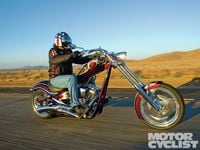When Big Dog Motorcycles surrendered to creditors this past April after 16 years of continuous production, it marked the end of an era for turnkey custom motorcycles. The Wichita, Kansas, firm was the biggest and strongest of the so-called “clone” manufacturers that emerged in the mid-’90s to fill a void for American-made cruisers at a time when Harley-Davidson couldn’t satisfy demand. Companies like Big Dog, Titan Motorcycle Company and American IronHorse began stamping out loose copies of Harley-Davidson motorcycles, typically powered by air-cooled, 45-degree, pushrod V-twins made by S&S; Cycle. Often built with the same aftermarket sheet metal and components, these bikes were initially indistinguishable from each other—hence the clone tag.
In a market that once supported as many as 100 such manufacturers, Big Dog always stood head-and-withers above the rest. CEO and company owner Sheldon Coleman—of Coleman Outdoor Company fame—guided Big Dog with a Fortune 500-level professionalism that was unmatched in the aftermarket motorcycle game. Big Dog was one of the first clone-makers to secure EPA and CARB homologation, one of the first to be listed in NADA and Kelly Blue Book value guides, and one of the few to invest in proprietary technology to set its choppers apart from the pack.
At its peak Big Dog occupied a 175,000 square-foot factory and employed 300 workers, supporting more than 100 dealers nationwide. In the mid-2000s, Coleman claimed Big Dog had more than 50 percent market share in the “Alternative American Cruiser” market segment. Big Dog eventually sold more than 25,000 motorcycles before succumbing to the fatal combination of chopper overexposure, a constricting credit market and a developing distaste for expensive, impractical recreational toys. RIP…

/cloudfront-us-east-1.images.arcpublishing.com/octane/IN263JIBTBCD3O265IMSCW6OZM.jpg)
/cloudfront-us-east-1.images.arcpublishing.com/octane/SMAQ354X2JH7NJATXNSQY4NRS4.jpg)
/cloudfront-us-east-1.images.arcpublishing.com/octane/GGOH2AQRSVHY5C5JLNEVYLB5SU.jpg)
/cloudfront-us-east-1.images.arcpublishing.com/octane/TJJEHV3ATZFFXHUYZABHXKE2DI.jpg)
/cloudfront-us-east-1.images.arcpublishing.com/octane/WIC4RXQ36BAXNIW6U4UJ3XDLKI.jpg)
/cloudfront-us-east-1.images.arcpublishing.com/octane/B4PQZLY4LBHITGE5ZRRM2N5YNU.jpg)
/cloudfront-us-east-1.images.arcpublishing.com/octane/OBYS7KWZUJFCHD44YPTSVM5EF4.jpg)
/cloudfront-us-east-1.images.arcpublishing.com/octane/FY7ZXYBT4NH2NGYQIWQVITS4AM.jpg)
/cloudfront-us-east-1.images.arcpublishing.com/octane/JPET6WQUDZEYLNXVY5LRNDRPLA.jpg)
/cloudfront-us-east-1.images.arcpublishing.com/octane/EY6P2QIFQJCDTNOMR3JB7WJED4.jpg)
/cloudfront-us-east-1.images.arcpublishing.com/octane/V2U6JB7KXNCQRN4OW6HNJTVMZQ.jpg)
/cloudfront-us-east-1.images.arcpublishing.com/octane/AMS43BT5ABH77NY7XKLCSZCNM4.jpg)
/cloudfront-us-east-1.images.arcpublishing.com/octane/NTK2ASYKUBDW5MQDWQLVQYOELY.jpg)
/cloudfront-us-east-1.images.arcpublishing.com/octane/SX7R3KCIANGDBGF45O73F543TM.jpg)
/cloudfront-us-east-1.images.arcpublishing.com/octane/ZTW4V7RAPFG6RFWJRXR2IX5ZQ4.jpg)
/cloudfront-us-east-1.images.arcpublishing.com/octane/EPRSLPIUTBC5RPD7R263BPV2D4.jpg)
/cloudfront-us-east-1.images.arcpublishing.com/octane/EMJ4I2T4HVCRVJPZ3UJFVMRDHA.jpg)
/cloudfront-us-east-1.images.arcpublishing.com/octane/CBDAM3VMJNFDBLE7Y3FY7RD5BY.jpg)
/cloudfront-us-east-1.images.arcpublishing.com/octane/CCEB3TNMU5FH3OZ4FKJ7DA2LBA.jpg)
/cloudfront-us-east-1.images.arcpublishing.com/octane/VV6N3KUWEVFJJD7F7VX6ICOH7Q.jpg)
/cloudfront-us-east-1.images.arcpublishing.com/octane/R55SVEXZ5VA2LCWFWYR647ASX4.jpg)
/cloudfront-us-east-1.images.arcpublishing.com/octane/MYWIEFOQ6JCCNDR4OBF5PU5LVE.jpg)
/cloudfront-us-east-1.images.arcpublishing.com/octane/OOZ3C4GCUJGRNONDI6DHVM57GI.jpg)
/cloudfront-us-east-1.images.arcpublishing.com/octane/JEKB3CMWXZD6ZAVFEDKLOQ5FNY.jpg)